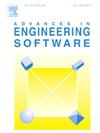Python-based machine learning estimation of thermo-hydraulic performance along varying nanoparticle shape, nanofluid and tube configuration
IF 4
2区 工程技术
Q2 COMPUTER SCIENCE, INTERDISCIPLINARY APPLICATIONS
引用次数: 0
Abstract
In this research article, a Python-based machine learning model prediction study was conducted based on the study results obtained from sudden expansion tubes containing different expansion angles, dimpled fin structures and nanofluids, whose thermo-hydraulic performance was previously examined. In the study, Artificial Neural Network and Ridge regression models were used to make predictions on the average Nusselt number (Nu), average Darcy friction factor (f) and performance evaluation criteria (PEC). Physical variations of the sudden expansion tube were taken into account and a detailed comparison of the results was made. A superior average Nu was acquired as 172.45 %, 22.05 %, 17.18 %, 13.65 %, and 7.76 % compared to Ag-MgO/H2O, Al2O3/H2O (blade), CoFe2O4/H2O, Al2O3/H2O (cylindrical), and Al2O3/H2O (platelet), respectively. The highest Performance Evaluation Criteria (PEC) for Re= 2000 based on Al2O3/H2O (platelet) shows an increase of 4.84 %, 12.08 %, 11.76 %, 66.05 %, and 148.94 % compared to Al2O3/H2O (cylindrical), Al2O3/H2O (blade), CoFe2O4/H2O, Fe3O4/H2O, and Ag-MgO/H2O, respectively. From the results obtained, it was determined that Python-based Machine Learning approach which facilitates custom optimizations showed a significant performance with small margins of error in predicting the heat transfer parameters. The lowest error rates of machine learning and polynomial ridge regression models ranged from 0.2 % to 5.4 % for the unseen test set and the application of Python-based algorithms provided considerable savings in calculation time compared to conventional methods. On the other hand, using machine learning models with feature engineering has been found to increase model performance by at least 30 %. In these years when studies on the predictions of thermo-hydraulic studies are very rare in the literature, this study is intended to facilitate scientists, engineers and academicians who will further study on this subject.
基于 Python 的机器学习估算不同纳米粒子形状、纳米流体和管道配置的热液性能
在这篇研究文章中,根据先前对含有不同膨胀角、凹凸翅片结构和纳米流体的突然膨胀管的热液性能进行的研究结果,开展了基于 Python 的机器学习模型预测研究。研究中使用了人工神经网络和岭回归模型来预测平均努塞尔特数(Nu)、平均达西摩擦因数(f)和性能评价标准(PEC)。考虑到突然膨胀管的物理变化,对结果进行了详细比较。与 Ag-MgO/H2O、Al2O3/H2O(叶片)、CoFe2O4/H2O、Al2O3/H2O(圆柱形)和 Al2O3/H2O(板状)相比,平均 Nu 分别为 172.45 %、22.05 %、17.18 %、13.65 % 和 7.76 %。与 Al2O3/H2O(圆柱形)、Al2O3/H2O(叶片形)、CoFe2O4/H2O、Fe3O4/H2O 和 Ag-MgO/H2O 相比,Al2O3/H2O(平板形)在 Re= 2000 时的最高性能评估标准(PEC)分别提高了 4.84%、12.08%、11.76%、66.05% 和 148.94%。研究结果表明,基于 Python 的机器学习方法便于进行定制优化,在预测传热参数方面表现出色,误差很小。对于未见测试集,机器学习和多项式脊回归模型的最低误差率在 0.2 % 至 5.4 % 之间,与传统方法相比,基于 Python 算法的应用大大节省了计算时间。另一方面,使用带有特征工程的机器学习模型可将模型性能提高至少 30%。近年来,关于热液研究预测的研究在文献中非常罕见,本研究旨在为进一步研究这一课题的科学家、工程师和学者提供便利。
本文章由计算机程序翻译,如有差异,请以英文原文为准。
求助全文
约1分钟内获得全文
求助全文
来源期刊

Advances in Engineering Software
工程技术-计算机:跨学科应用
CiteScore
7.70
自引率
4.20%
发文量
169
审稿时长
37 days
期刊介绍:
The objective of this journal is to communicate recent and projected advances in computer-based engineering techniques. The fields covered include mechanical, aerospace, civil and environmental engineering, with an emphasis on research and development leading to practical problem-solving.
The scope of the journal includes:
• Innovative computational strategies and numerical algorithms for large-scale engineering problems
• Analysis and simulation techniques and systems
• Model and mesh generation
• Control of the accuracy, stability and efficiency of computational process
• Exploitation of new computing environments (eg distributed hetergeneous and collaborative computing)
• Advanced visualization techniques, virtual environments and prototyping
• Applications of AI, knowledge-based systems, computational intelligence, including fuzzy logic, neural networks and evolutionary computations
• Application of object-oriented technology to engineering problems
• Intelligent human computer interfaces
• Design automation, multidisciplinary design and optimization
• CAD, CAE and integrated process and product development systems
• Quality and reliability.
 求助内容:
求助内容: 应助结果提醒方式:
应助结果提醒方式:


